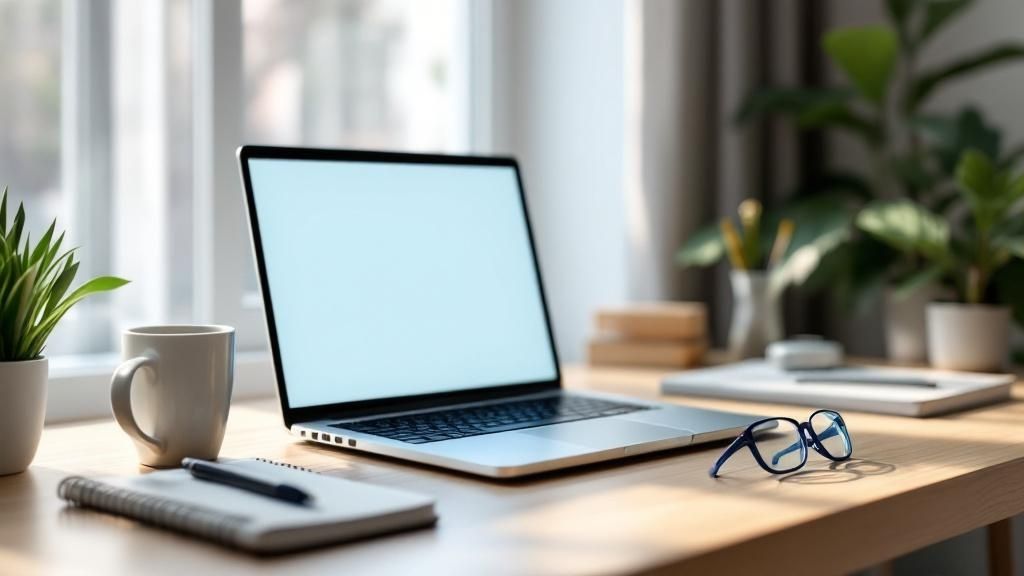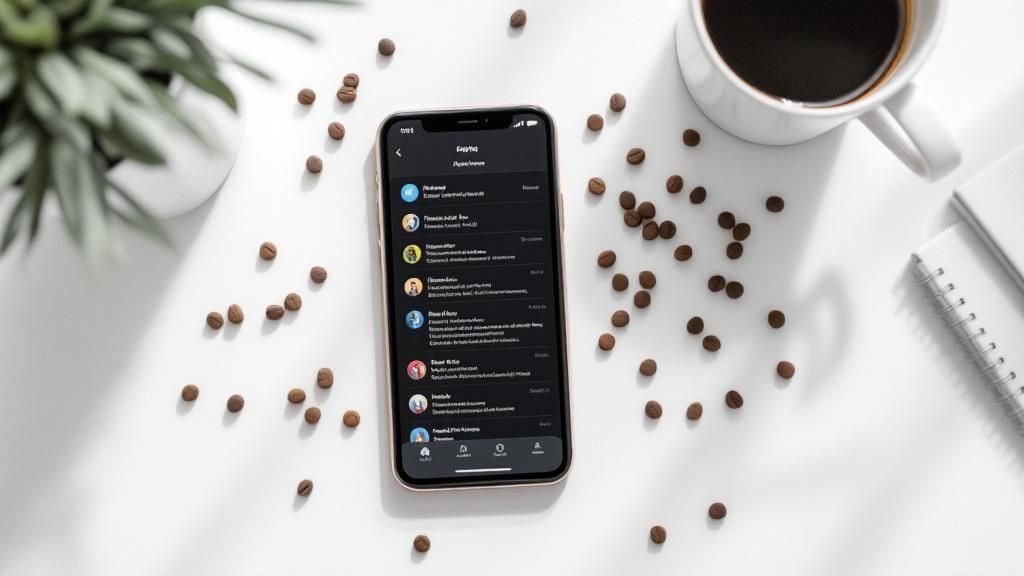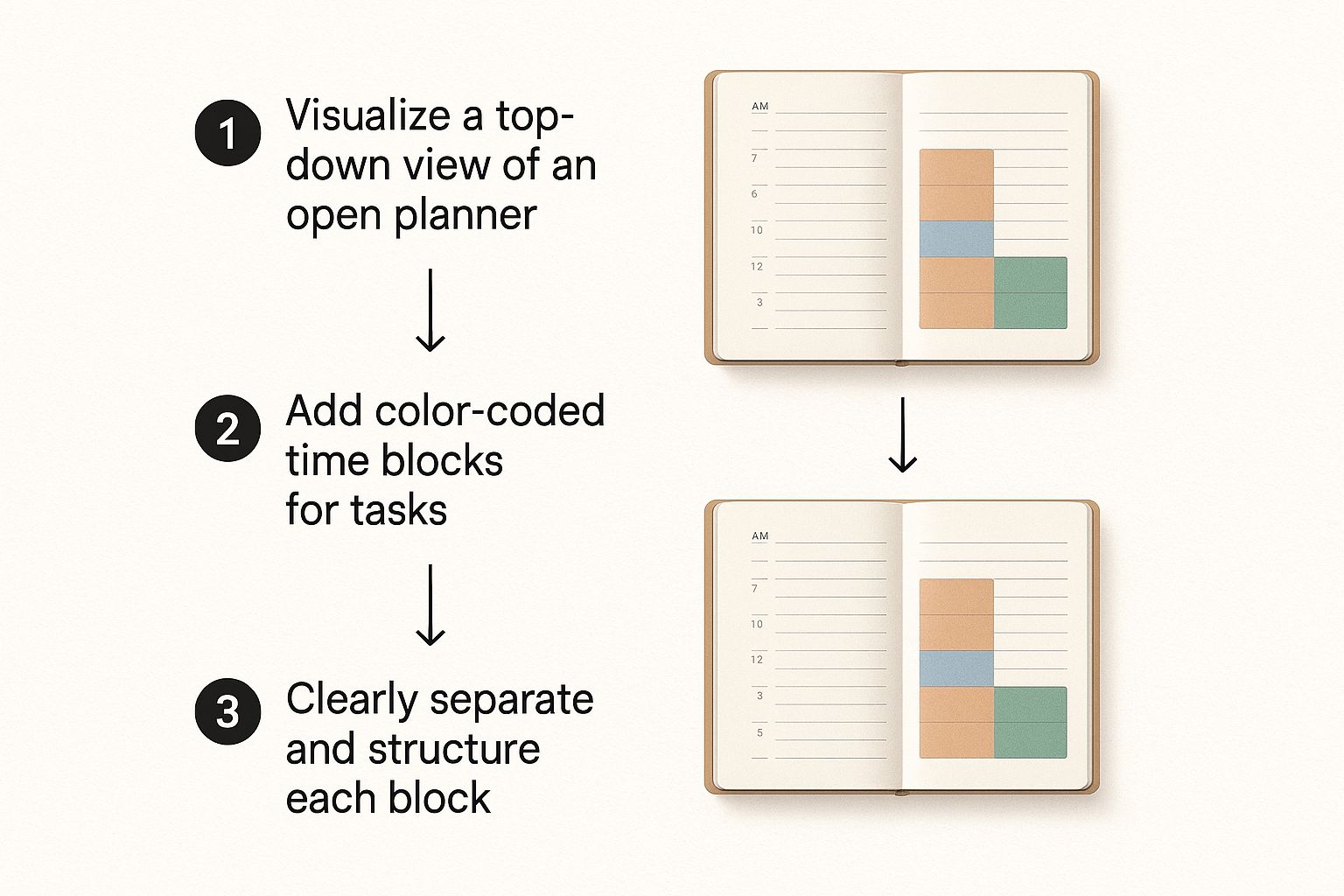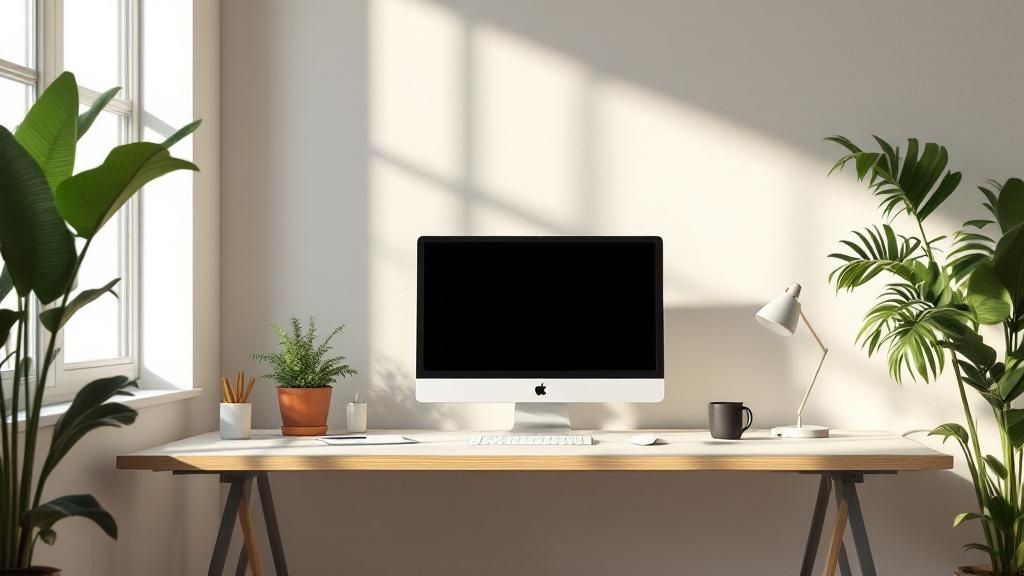
How to Stay Focused at Work and Boost Productivity
If you're trying to figure out how to stay focused at work, it really boils down to getting a handle on three things: your environment, your tasks, and your own mental state. It's less about force and more about finesse—building a fortress against digital distractions, giving your day some much-needed structure, and knowing when to step back and let your mind recharge.
Why Is It So Hard to Focus at Work

Does your focus feel like it's constantly under attack? You're definitely not imagining it. The modern workplace—whether that's a bustling office or your own kitchen table—often feels like a battlefield for your attention. Digital pings, the always-on pressure of constant connectivity, and ever-changing work environments create a perfect storm for killing productivity.
This isn't just a vague feeling of being stressed out; it has a real, measurable impact. This constant fight for concentration is a massive issue. In fact, a recent study found that nearly half of employees globally feel they're productive less than 75% of the time.
The cost of this fractured attention is enormous, leading to everything from personal burnout to significant losses for businesses. When our focus dips, the quality of our work suffers, deadlines start slipping, and innovation just grinds to a halt.
The Four Pillars of Workplace Focus
So, how do we fix this? The key isn't just to "try harder" or tell people to ignore distractions—that approach completely misses the real issues, like chaotic workflows or a company culture that rewards constant interruptions. To truly learn how to stay focused, you have to build a solid foundation that actually supports deep, concentrated work.
I've found that the most effective approach is built on what I call the "Four Pillars of Workplace Focus." We'll dig into each of these, but here's a quick roadmap of what we're going to cover.
| The Four Pillars of Workplace Focus | ||
|---|---|---|
| Focus Pillar | Core Principle | Key Benefit |
| Mastering Your Environment | Turn your physical and digital space from a field of distractions into a fortress for concentration. | Fewer interruptions and a clear space to do your best work. |
| Mastering Your Tasks | Bring order to your to-do list and work with intention, not just reacting to whatever comes your way. | A clear plan, less overwhelm, and more intentional progress. |
| Mastering Your Mindset | Protect your mental energy from digital fatigue and use strategic rest to achieve peak performance. | Better mental clarity, reduced burnout, and sustainable high performance. |
| Protecting Your Eyes | Reduce digital eye strain and the mental fatigue it causes by using tools like blue light blocking glasses. | Less eye fatigue, improved sleep, and longer periods of sustained focus. |
By tackling these core areas, you're moving beyond simple "focus hacks" and starting to build a reliable system for producing high-quality, concentrated work. It’s a powerful shift in perspective. You can explore more proven strategies to improve workplace efficiency to see how these ideas fit into a larger productivity framework.
Ultimately, focus isn't a switch you just flip on. It’s a skill you have to cultivate through deliberate practice and by creating an environment—both internal and external—that allows it to flourish.
Build an Environment That Protects Your Focus
Your workspace—both the physical one on your desk and the digital one on your screen—is either a fortress for your focus or a wide-open field of distractions. If you're serious about getting more done, you have to start by building that fortress. This isn't about some sterile, minimalist fantasy; it's about being intentional with your surroundings so they support deep work instead of sabotaging it.
Your physical environment really sets the stage. A cluttered desk isn't just messy; it's a source of constant, low-level mental static. Every out-of-place item is a tiny decision you haven't made yet, and each one subtly pulls at your attention. A great first step is to clear everything off your desk that isn’t absolutely essential for the task at hand. This simple act can create a powerful psychological shift, telling your brain it’s time to lock in.
If you work from home, this means setting firm boundaries. Maybe that’s a dedicated office with a door you can actually close, or maybe it's just clearly communicating your "do not disturb" hours to your family. For those in an open office, a good pair of noise-canceling headphones is a non-negotiable tool for carving out your own private bubble of concentration.
Tame Your Digital World
Let's be honest: your digital environment is usually a far bigger threat to your focus than any physical clutter. Non-essential notifications are the main culprits here, brilliantly designed to hijack your attention with a false sense of urgency. The single most impactful thing you can do is to ruthlessly silence them.
Turn off all notifications on your computer and phone, except for the absolute essentials. I’m talking about email pop-ups, social media alerts, and news updates. An HR manager at a highly productive Danish bank once mentioned that the only notification that gets through on his phone is an actual phone call. That's the level of digital minimalism we're aiming for if we want real focus.
Key Takeaway: You don't need to be constantly available. Responding instantly is a habit, not a requirement. Batch-checking emails and messages two or three times a day is far more effective than letting them interrupt your workflow every few minutes.
Beyond just notifications, get smart about your digital tools. I’ve found that using two separate browser windows—one strictly for work with only work-related bookmarks, and another for everything else—makes a huge difference. When that inevitable moment of mental pause arrives, the easy-to-access distractions just aren't there, encouraging you to stay on task instead of defaulting to a quick scroll through social media.
Optimize Your Sensory Inputs
Once you've decluttered, think about the sensory inputs that affect your mind. Things like proper ergonomics and lighting aren't just about physical comfort; they directly impact your mental stamina and ability to concentrate.
- Ergonomics: An uncomfortable chair or a poorly positioned monitor creates physical strain, which quickly turns into mental fatigue. Make sure your chair supports your back, your feet are flat on the floor, and your screen is at eye level.
- Lighting: Bad lighting can cause eye strain and headaches, making it nearly impossible to hold your focus. Natural light is always best. Beyond just opening the blinds, understanding the health benefits of installing a skylight shows how simple environmental changes can significantly boost well-being and concentration.
- Air Quality: A stuffy, stale room can make you feel drowsy and unfocused. Just cracking a window for a few minutes can refresh both the air and your mind.
These physical adjustments all contribute to your overall well-being, which is the foundation of high performance. For more ideas on this, you might find our guide on how to stay healthy in the modern office helpful. By taking control of your physical and digital spaces, you build a resilient environment where focus can finally thrive.
Use Strategic Task Management for Deep Work
Staring at a massive, overwhelming to-do list is a guaranteed way to kill your focus. Once you've sorted out your physical and digital spaces, the next real step in figuring out how to stay focused at work is to apply that same deliberate structure to your actual workflow. This is all about shifting from a reactive mode—where you’re just bouncing from one fire to the next—to a proactive one where you’re in control.
This doesn't mean you need a suffocating, minute-by-minute schedule. It's more about adopting a system that gives you clarity on your real priorities. Tried-and-true systems like time blocking, the Pomodoro Technique, and the Eisenhower Matrix give you a solid framework for managing your day with intention, not just reacting to whatever chaos comes your way.
Structure Your Day with Time Blocking
Time blocking is a simple but incredibly powerful method where you schedule specific blocks of time for specific tasks right on your calendar. Instead of just working off a running list, you're giving every single task a dedicated home in your day. This naturally stops you from multitasking and forces you to be honest about what you can actually get done.
Think of a project manager juggling multiple deadlines. They might block out 9-11 AM for "Finalize Q3 Report," carve out a 30-minute slot for email triage, and then block another two-hour chunk for a client presentation. This creates clear, protected zones for your most important work, shielding it from constant interruptions.
This image shows what a well-structured, time-blocked day can look like.

The color-coded blocks turn a vague schedule into a clear, actionable plan, making it so much easier to commit to one thing at a time. To get the most out of this, using the right tools can be a game-changer. You can find an ultimate guide to digital planners that can help you organize and streamline your workflow perfectly for deep work.
Use Short Bursts of Intense Focus
Another fantastic technique is the Pomodoro Technique. It's surprisingly simple: you work in focused 25-minute intervals, separated by short five-minute breaks. After you complete four of these "Pomodoros," you treat yourself to a longer break of 15-30 minutes.
This method works wonders for a few key reasons:
- It beats procrastination: The idea of tackling a massive project for hours is paralyzing. But committing to just 25 minutes? That feels totally doable.
- It prevents burnout: Those built-in breaks force you to step away and rest your brain, which helps keep your energy high all day long.
- It trains your focus: Over time, this practice actually builds your "focus muscle," making it easier to ignore distractions and stay locked in for longer.
A writer staring at a blank page could use this to break through a creative block. By simply committing to 25 minutes of uninterrupted writing, they can often break the inertia and get the words flowing again.
The core idea here is that sustained focus isn't just about raw willpower. It’s about working with your brain's natural rhythms, not fighting against them.
Prioritize What Truly Matters
Finally, let's be real: not all tasks are created equal. The Eisenhower Matrix is a straightforward but powerful tool for separating what's truly important from what's merely urgent. It divides all your tasks into four simple quadrants:
- Urgent and Important: Do these right away.
- Important, but Not Urgent: Schedule these to do later.
- Urgent, but Not Important: Delegate these if you can.
- Neither Urgent nor Important: Get rid of these.
Using this matrix is the key to escaping the "urgency trap," where you spend your entire day putting out small fires that don't actually move you toward your bigger goals. By consistently making time for your Quadrant 2 tasks, you shift from a constant state of crisis management to one of strategic, meaningful accomplishment.
Fight Digital Strain to Sharpen Your Mind
Let's be honest, constant screen time is one of the biggest hidden enemies of our concentration. It’s not just about willpower; our eyes are being bombarded with high-energy blue light all day long. This can lead to headaches, blurry vision, and a general mental fog that makes deep work feel like an uphill battle.
If you want to learn how to stay focused at work in today's world, tackling this digital fatigue is non-negotiable.
One of the most direct ways to handle this is by filtering the problem at its source. I’ve found that wearing specialized eyewear designed to block blue light makes a massive difference. Think of these glasses as a protective shield for your eyes, easing the constant burden and letting you stay locked in for longer periods without that familiar strain.
Many people tell me that after just a few days of wearing them, the end-of-day headaches and that “fried brain” feeling really start to fade away. It’s a small change with a huge ripple effect, often leading to better sleep—which is absolutely vital for staying sharp.
Adopt Proactive Eye Care Habits
Beyond just wearing glasses, you need to build some simple, proactive habits into your workday to give your eyes a break. The most famous one is the 20-20-20 rule, and it’s famous for a good reason—it works. It's a dead-simple exercise to combat digital eye strain.
Every 20 minutes, take a 20-second break to look at something at least 20 feet away.
This tiny reset gives your eye muscles a chance to relax, preventing the fatigue that sneaks up on you after hours of staring at a screen just inches from your face.
I recommend setting a recurring timer on your phone or computer. It might feel a little disruptive at first, but you'll quickly notice a drop in eye fatigue and a real improvement in your ability to power through the afternoon slump. It’s a small time investment that pays off big in mental clarity.
Optimize Your Screen and Take Breaks
Don't forget about your screen's settings, either. A display that's too bright or too dim forces your eyes to work overtime. You want to adjust your monitor’s brightness so it matches the ambient light in your room. It shouldn't feel like you're staring into a lamp or squinting to see in the dark.
And when you take a break, make it a real break. Don’t just switch from your computer screen to your phone screen. Get up. Stretch. Walk to the kitchen for a glass of water, or just spend a minute staring out a window. These little microbreaks give both your eyes and your brain a much-needed reset.
For a deeper dive into protecting your vision, check out our guide on how to reduce eye strain for even more strategies. When you actively manage how you interact with your screens, you're protecting your most valuable asset for getting things done: your focus.
Use Breaks and Boundaries to Hit Peak Performance

The "always-on" hustle culture we see everywhere is a massive threat to our ability to focus. I've learned over the years that real productivity isn't about logging more hours; it's about working smarter and knowing when to rest. Downtime isn't just nice to have—it's a critical tool for high performance.
Your brain absolutely needs breaks to sort through information, store memories, and gear up for the next task. Trying to power through mental fatigue just leads to sloppy work and, eventually, complete burnout. A huge part of staying focused at work is knowing when to step away from it.
Embrace Strategic Microbreaks
Taking a good break is a skill. A fantastic place to start is by scheduling short, intentional pauses throughout your day. The trick is not to wait until you're already feeling fried.
Even a simple five-minute break every hour can make a world of difference. When you take it, fully disconnect from what you were doing. Stand up, stretch, walk around the room, or just look out a window. The goal is to give your brain a complete context switch, which helps stop that slow drain on your concentration.
Key Insight: A break isn't about stopping work. It's about getting yourself ready to come back to it with fresh eyes and renewed energy. Think of it as hitting the reset button on your brain's operating system.
Once you make these short breaks a non-negotiable part of your routine, you'll notice your focus is much sharper when you're actually at your desk. It’s a proactive way to keep your brain running at full capacity all day, not just for the first couple of hours.
Set and Communicate Firm Boundaries
Just as important as taking breaks is creating a clear line between your work life and your personal life. With everything being so connected these days, this is tougher than ever, but it’s vital for your long-term focus and sanity. The first step is to define your work hours and really stick to them.
Telling your team about these boundaries is how you make them stick. You can do this professionally without coming across as unhelpful. A simple line in your email signature like, "I respond to messages between 9 AM and 5 PM," often does the trick. If a non-urgent request comes in after hours, fight the urge to reply right away. Answering it first thing the next morning sends a clear, consistent message.
Of course, the ability to switch off is shaped by bigger things, too. The 2025 Global Life-Work Balance Index from Remote.com highlights a strong connection between national policies on work hours and leave with overall employee well-being. It turns out that countries with better policies often have workers who can maintain focus more effectively.
On a more personal level, figuring out how to limit screen time after you clock out is a game-changer. It helps you create that healthy separation and protects your mental energy for the next day, ensuring your time off actually recharges you for when you’re back at work.
Of course. Here is the rewritten section, designed to sound like it was written by an experienced human expert, following all your specified requirements.
Common Questions About Staying Focused at Work
Knowing the best strategies for focus is one thing. Actually putting them into practice when your motivation has vanished or a colleague keeps pinging you is a whole different ball game. It’s easy to talk about focus, but living it out day-to-day brings up real challenges.
This is where the rubber meets the road. Let's dig into some of the most common questions and roadblocks people hit when they’re trying to lock in and get work done. Think of this as your troubleshooting guide for fine-tuning these techniques to fit your actual work life.
How Do I Handle Persistent Interruptions?
We’ve all been there. You’re deep in concentration, and suddenly a coworker is at your desk or a "quick question" pops up in your chat app. That little interruption can completely shatter your flow, and it often takes way longer to get back on track than the interruption itself. The trick is to be polite but firm in protecting your time.
If someone stops by in person, try saying something like, "I'm right in the middle of something that needs my full attention. Can I swing by your desk in about 30 minutes?" This respects their request while safeguarding your focus block. For digital pings, it's perfectly fine to let them sit for a bit. Setting your status to "Focusing" or "Deep Work" can also work wonders as a friendly "do not disturb" sign.
Remember this: You are not obligated to provide an instant response to every request. Learning to create a respectful delay is a crucial skill for protecting your deep work time and preventing your day from being dictated by others' agendas.
What if I Have Zero Motivation?
Let's be real: some days, the motivation just isn't there. On those days, the whole "just do it" mentality is not only unhelpful, it’s downright terrible advice. Instead, you need to make the task so small that starting feels almost effortless. This is where the Pomodoro Technique really shines.
Forget about tackling the entire, overwhelming project. Just make a deal with yourself to do one, single 25-minute focused work session. That's it. Anyone can do something for just 25 minutes. More often than not, simply getting started is the spark you need to build momentum and keep the fire going.
How Do I Stay Focused in a Remote Setting?
The massive shift to remote and hybrid work has completely changed the game. Sure, you might have traded office chatter for quiet, but a whole new world of home-based distractions has taken its place. Before the pandemic, only about 4.1% of the U.S. workforce regularly worked from home. That number shot up to 69% at its peak in 2020. You can dive deeper into how telecommuting has reshaped the modern workforce on GlobalWorkplaceAnalytics.com.
To stay focused when you work from home, it's all about creating clear boundaries—both physical and mental.
- Designate a Workspace: This is non-negotiable. Have a specific spot in your home that is only for work. When you're there, you're on the clock. When you leave, you're done for the day.
- Set Clear Hours: Let your colleagues and your family know your work hours. This manages expectations and helps prevent personal life from bleeding into your workday.
- Replicate Your Commute: Use the time you used to spend commuting to build a "start of day" ritual. A short walk, a podcast, or even just making a specific type of coffee can signal to your brain that it's time to switch into work mode.
These small rituals are powerful. They help your brain flip the "on" and "off" switch for work, keeping your focus sharp when it counts and protecting your personal time.
Protecting your focus in a digital-first world often starts with protecting your eyes. Spektrum Glasses offers premium blue light blocking eyewear designed to reduce digital eye strain, minimize headaches, and help you maintain concentration for longer. Discover how our stylish, science-backed glasses can make your workday more comfortable and productive at https://www.spektrumglasses.com.
